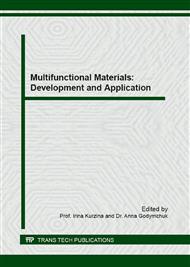[1]
V.V. Kramarenko, Soil Science: Study Guide, TPU Publishing House (in Russian), Tomsk, (2011).
Google Scholar
[2]
S.B. Marković, U. Hambach, T. Stevens and other, Loess in the Vojvodina region (Northern Serbia): an essential link between European and Asian Pleistocene environments, Netherlands J. Geosci. 91 (2012) 173-188.
DOI: 10.1017/s0016774600001578
Google Scholar
[3]
Road Industry Coad, Design Flexible Pavements, Informavtodor Publishing House (in Russian), Moscow, (2001).
Google Scholar
[4]
RStO 01, Richlinien fur die Standartisierung des Oberbaues von Verkehrsfiuchen, Bonn, (2001).
Google Scholar
[5]
RVS 8S. 06. 32, Ausstrian Association for Research on Road, Rail, and Transport, Guidelines and Specifications for Road Construction, Ausstria, (2006).
Google Scholar
[6]
SETRA-LCPC French design manual for pavement structures, technical Guide, Editions et Cecile Legrand-Ferroniere, French, (1999).
Google Scholar
[7]
Interim Advice Note 73/06 Revision 1. Design Guaidance for Road Pavement Foundations (Draft H25), (2009).
Google Scholar
[8]
S.V. Efimenko, M.V. Badina, Road Zoning of the West Siberia Territory, TSUAB Publishing House (in Russian), Tomsk (2014).
Google Scholar
[9]
Russian Construction Codes, Road, Moscow (in Russian), (2004).
Google Scholar
[10]
V.N. Efimenko, S.V. Efimenko, Theoretical justification of road-climatic zoning of the southeast of Western Siberia, Journal Vestnik of TSUAB, (in Russian). 2 (2001) 5-10.
Google Scholar
[11]
S.V. Efimenko, A.V. Sukhorukov, O.V. Konyayeva, Using mathematical models to provide reliability of transport facilities, Adv. Mater. Res. 1085 (2015) 507-512.
DOI: 10.4028/www.scientific.net/amr.1085.507
Google Scholar
[12]
Yaning Qiao, Gerardo W. Flintsch, Andrew R. Dawson, Tony Parry, Examining effects of climatic factors on flexible pavement performance and service life transportation research record, Transportation Res. Board. 2349 (2013) 100-107.
DOI: 10.3141/2349-12
Google Scholar
[13]
D. H. KEVIN, S. Rao, Predicting subgrade moisture content for low-volume pavement design using in situ moisture content data, Transport Res. Rec. 1652 (1999) 98-106.
DOI: 10.3141/1652-47
Google Scholar
[14]
C.E. Zapata, W.N. Houston, Calibration and validation of the enhanced integrated climatic model for pavement design, Transport. Res. Board. 62 (2008) 61.
Google Scholar
[15]
I.A. Zo1otar, Method of predicting the strength parameters of roadbed of silty soils in regions I and II or road-climatic zones with aid of a computer, Cold Reg. Res. and Eng. Laboratory Hanover, New Hampshire (1972) 1-19.
Google Scholar
[16]
V.N. Efimenko, The Water-and-thermal Regime of the Subgrade During Deep Soil Freezing (on the Example of the South-East of Western Siberia), Moscow (in Russian), (1978).
Google Scholar
[17]
V.N. Efimenko, S.V. Efimenko, M.V. Badina, A.V. Grigoriev, The account of regional natural-climatic conditions in specification of road design standards, Sci. and Technol. in the Road Sector (in Russian). 1 (2012) 15-17.
Google Scholar


